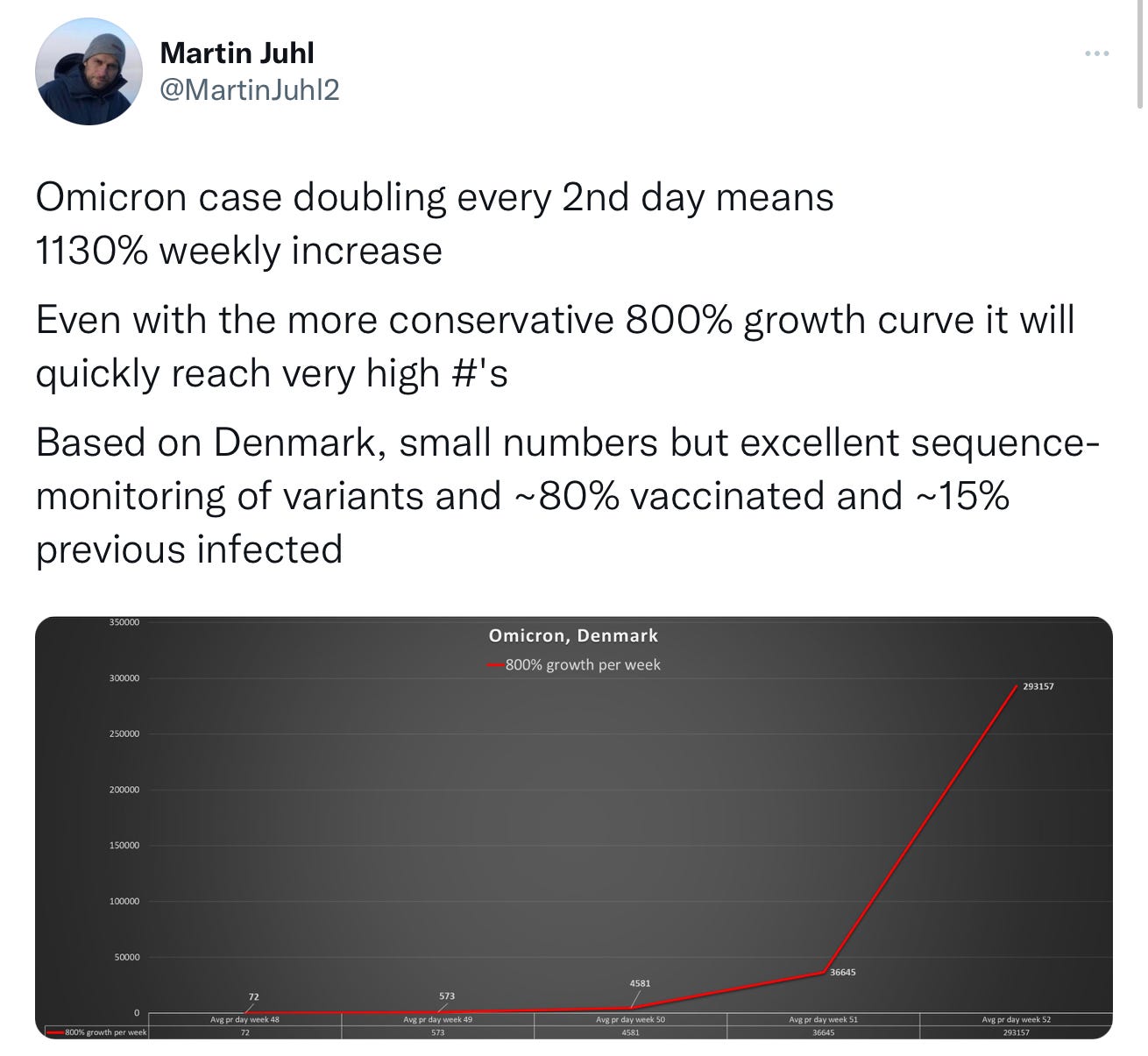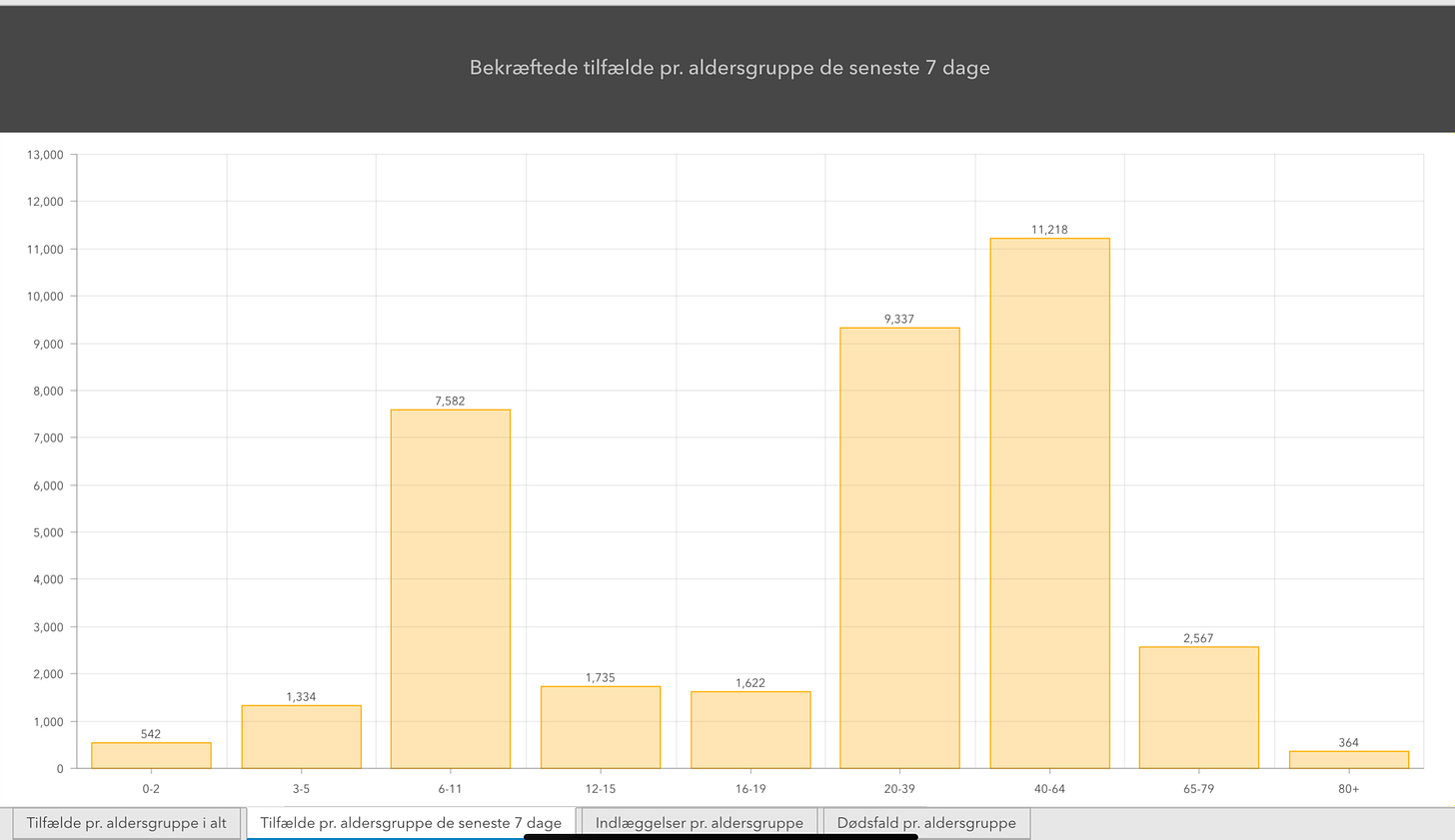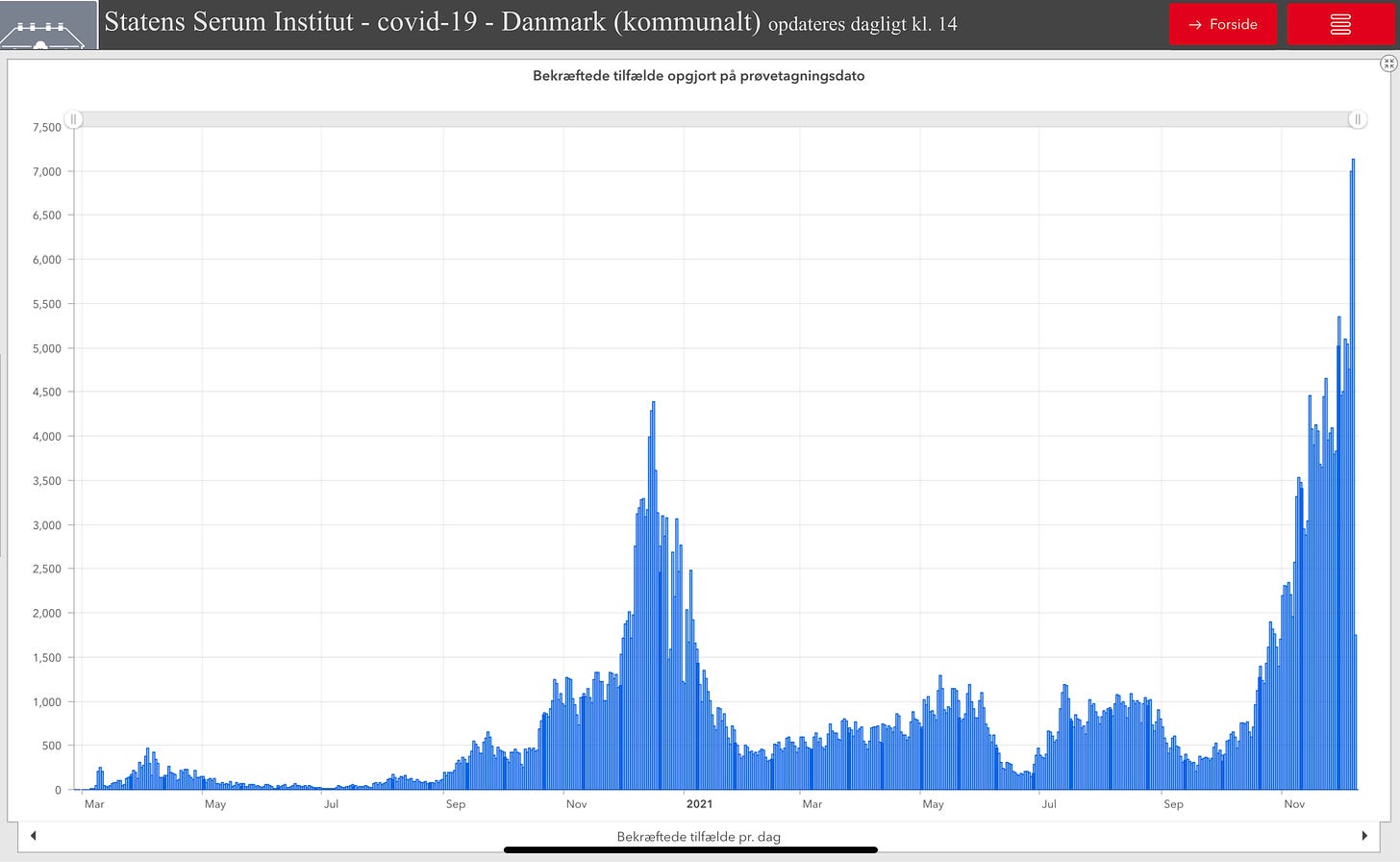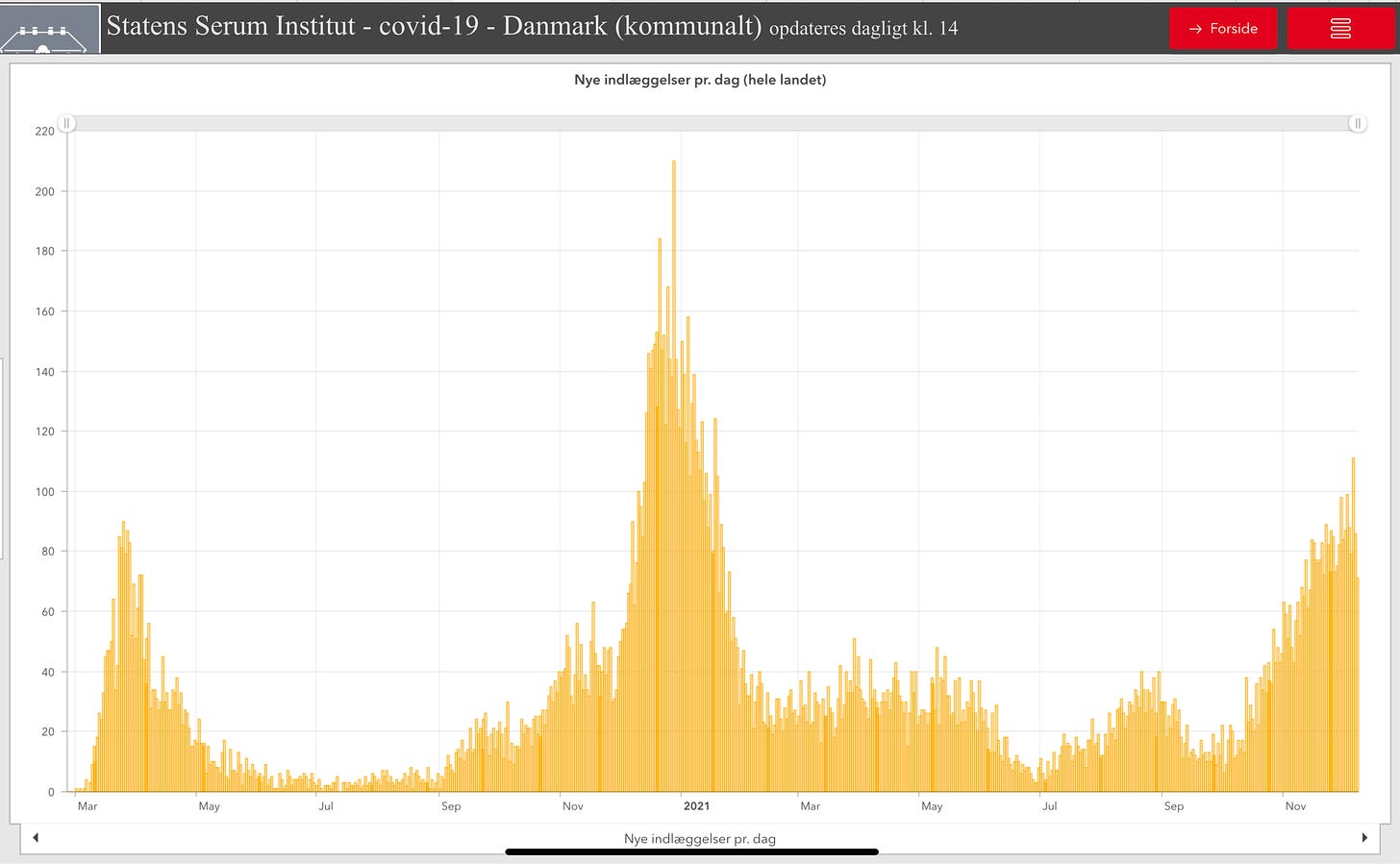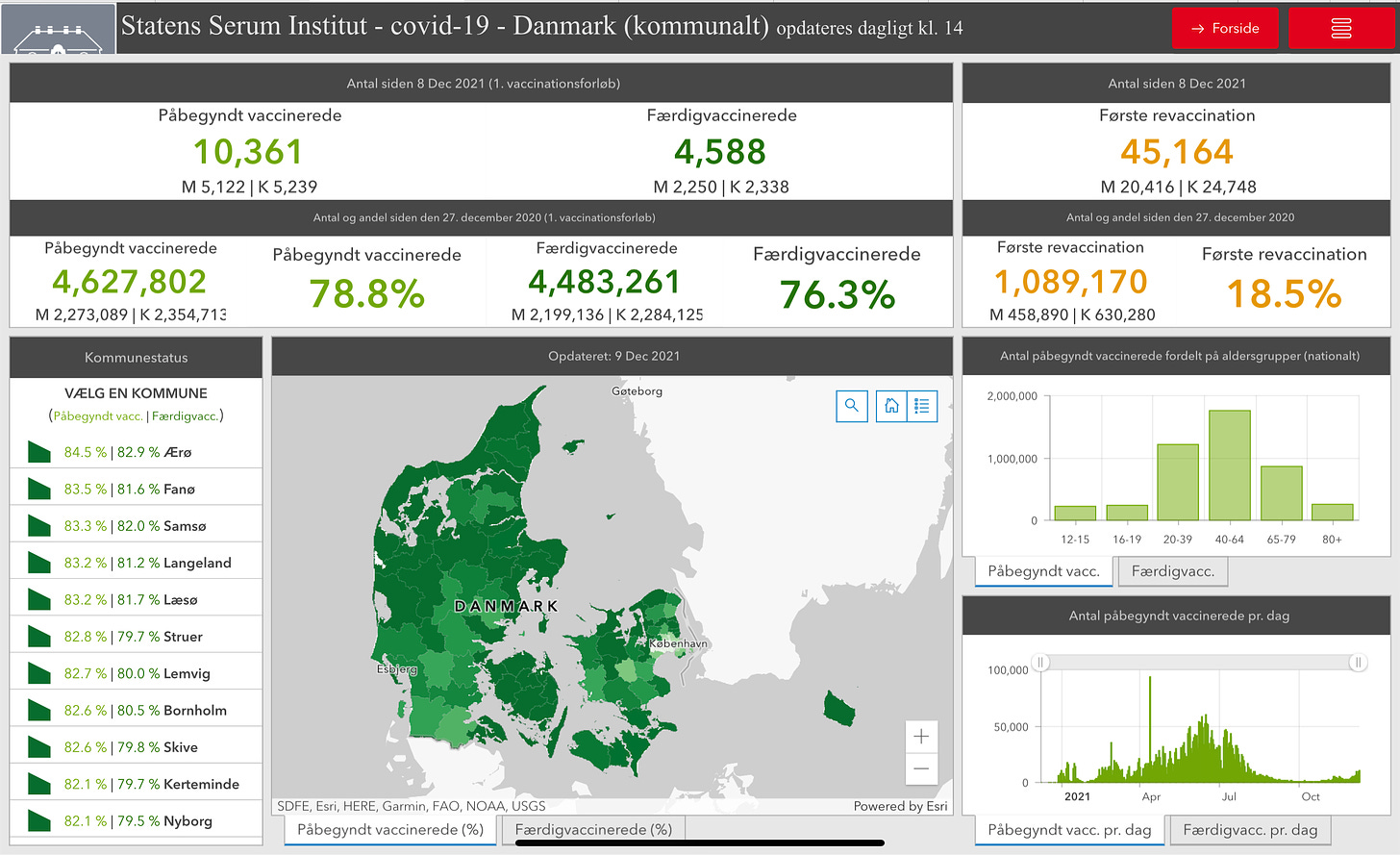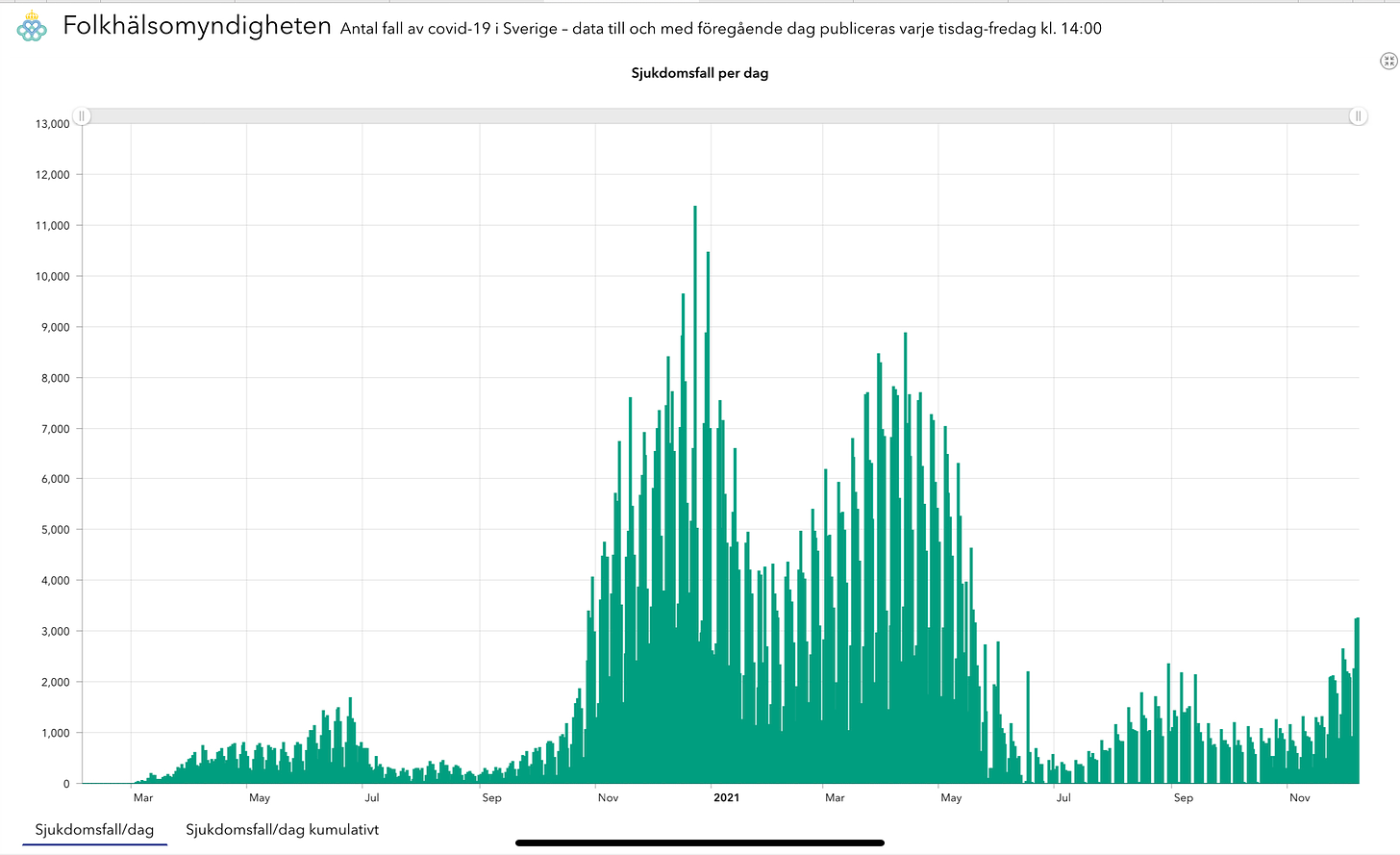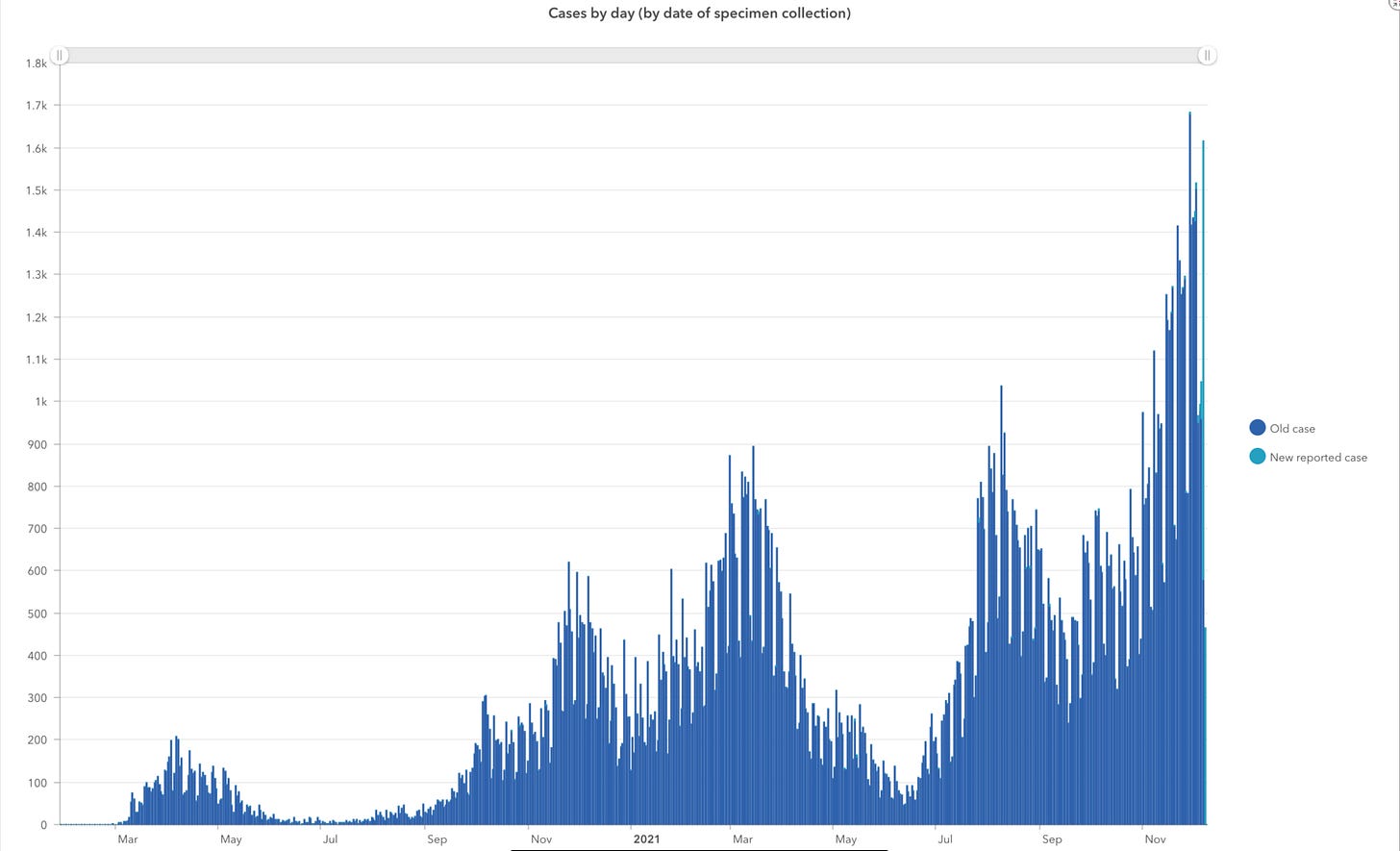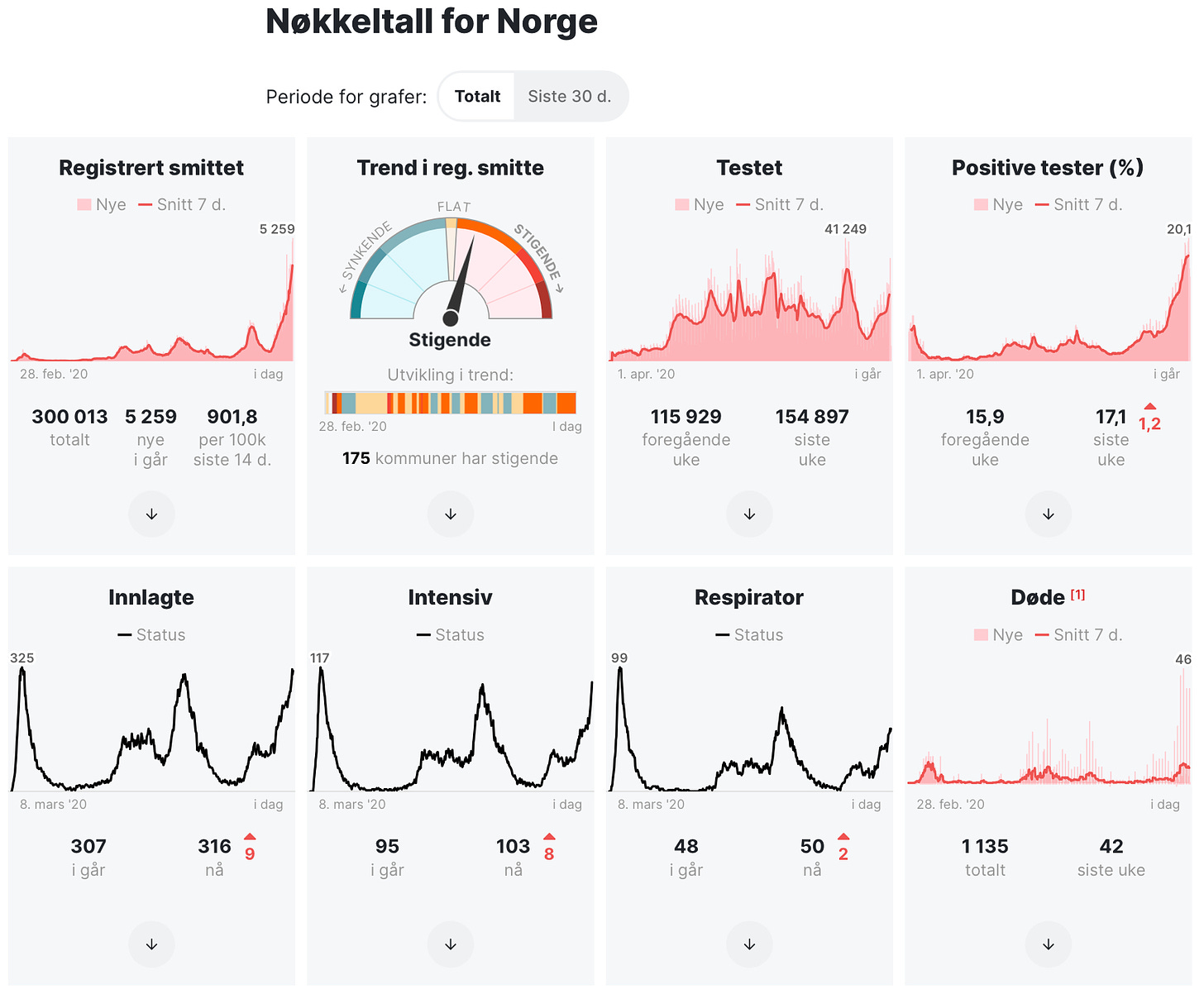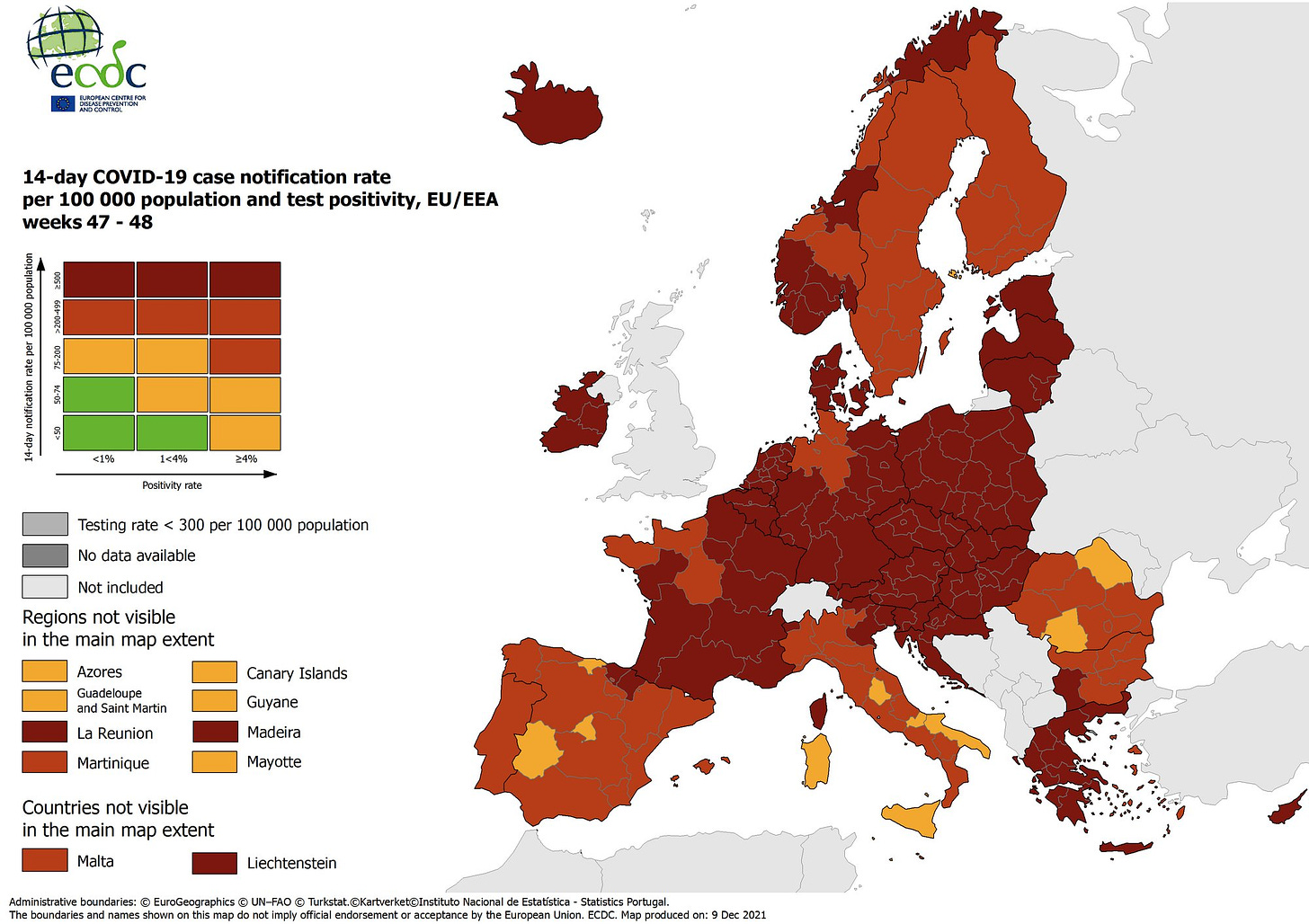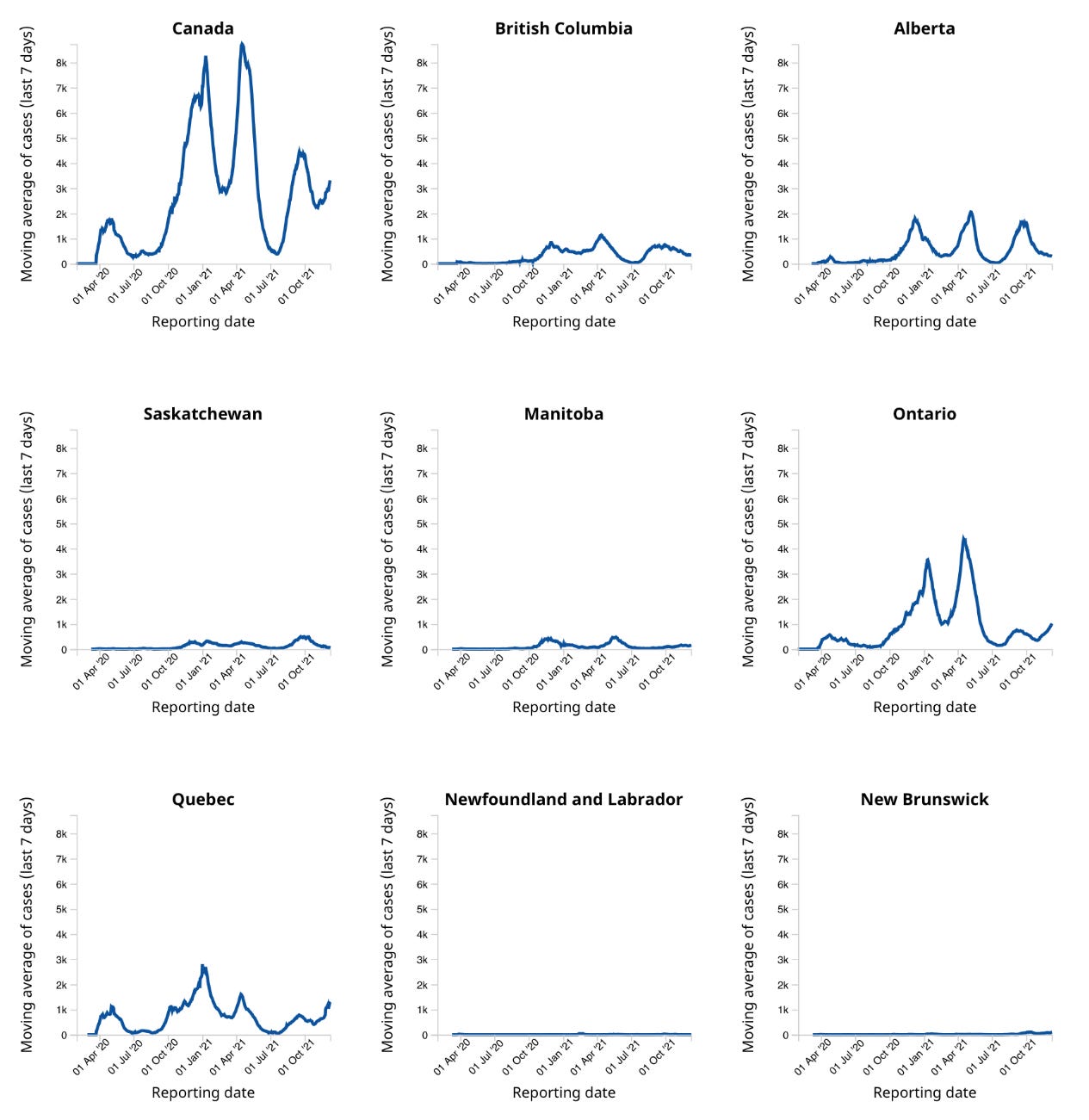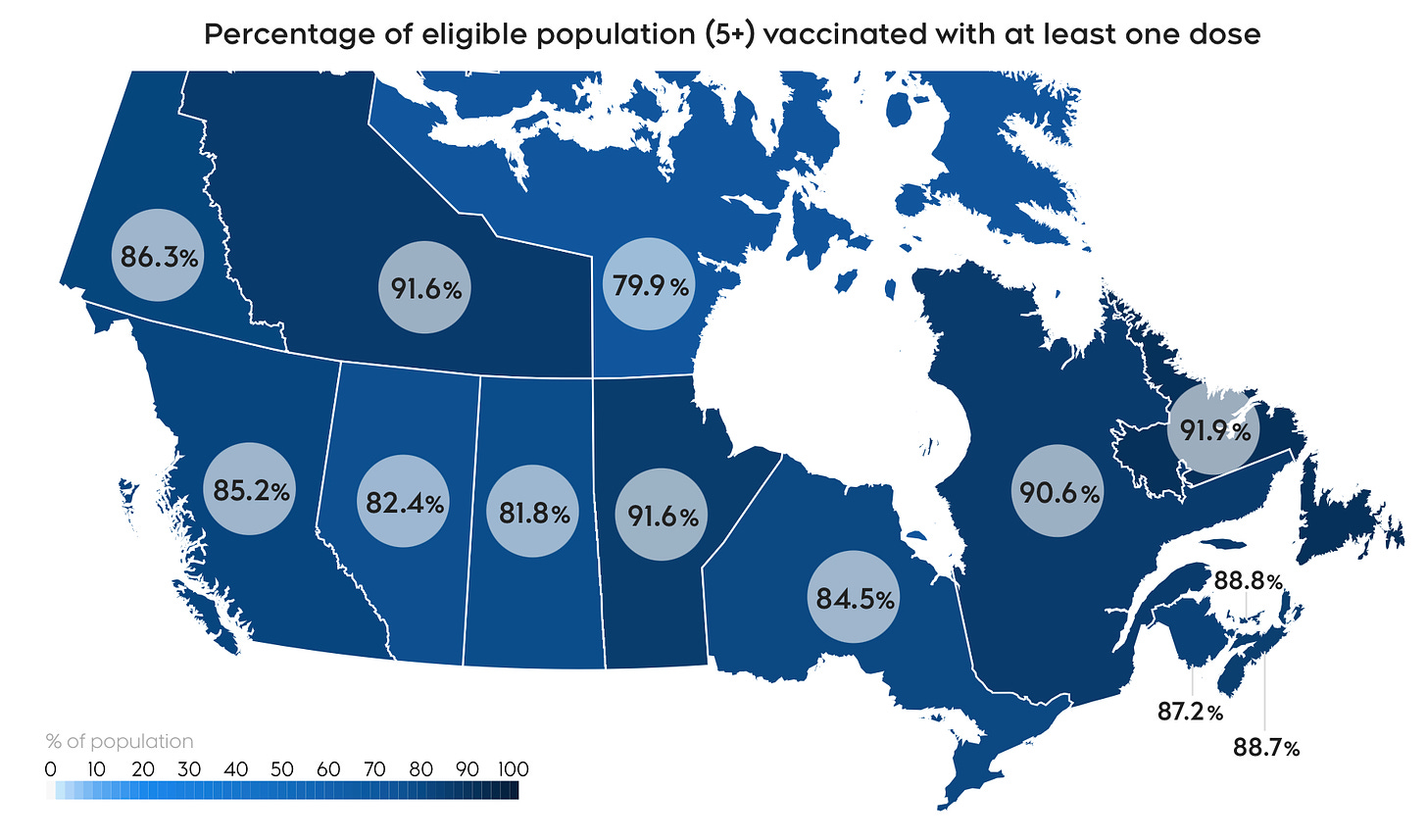🇩🇰
The Omicron variant is spreading across Denmark at a speed that is really quite stunning. It is making the Delta variant look like a slow mover. On Thursday, the Staten Serum Institut confirmed total cases of the new variant had risen to 796, a significant increase on the previous day’s 577, and a massive increase from the 18 Omicron cases reported just last Friday.
-
The epidemic situation in Denmark continues to look grim even as the Omicron variant spreads like wildfire. In its latest assessment, the Staten Serum Institut notes both overall infection numbers and hospitalizations continue to increase.
From week 47 to 48 (last week and the week before) infections increased by 19% and hospital admissions were up 9.6%. The SSI notes that from week 46 to 47 the increase was 3% and 3.3% respectively, meaning the epidemic is picking up steam. The national COVID incidence rate per 100,000 people also continues to rise, going from 495 to 588 week to week. Metro Copenhagen continues to be a Danish coronavirus hot spot with a COVID incidence rate more than double any other region in Denmark.
Infection numbers among children six to 11 years old continue to see new record highs. The institute says “the infection [activity] is still clearly highest among school children.” Last week the COVID incidence rate among that age group was a jaw-dropping 1,959 per 100,000 kids, up from 1,675 the week prior. “It is far higher than for the other age groups and by far the highest incidence at any point in the pandemic.”
Ward Doctor Rebecca Legarth:
“The picture has been like this for a number of weeks, and it still is. It is still the infection among the 6-11-year-olds, where up to 2% of the age group became infected in week 48, which is helping to drive the epidemic.”
Infections over the last seven days by age group
The Staten Serum Institut’s COVID snapshot says the other major concern is, of course, the new Omicron variant.
“Parallel to the development of the general epidemic, which is still mainly driven by the Delta variant, we are now seeing this sharp growth in the number of cases of Omicron. During week 48, we have seen incipient community infections with the variant. Much of this infection has been seen in connection with super-spreading events.”
There is some good news in the report. COVID deaths have declined 12% from one week to the next.
The SSI says all the data from last week, like the week’s before, show that being vaccinated offers by far the best protection. Unvaccinated people 12 years old and older are 2.6 times more likely to get infected and have a 4.2 times higher chance of ending up in the hospital.
“It is quite clear that the vaccines give less risk of infection among the vaccinated and provide better protection against becoming seriously ill if you become infected anyway. According to our figures, there are currently 38 admissions per 100,000 among unvaccinated against 9 per 100,000 among vaccinated calculated for all groups from 12 years and up.”
-
Denmark is reporting 6,985 infections and 11 more coronavirus deaths in the last day.
Yesterday, there were 458,022 total corona tests done, of which 216,868 were PCR tests equaling a positivity percentage of a very high 3.22%.
On Thursday, Denmark posted record high infection numbers in two different ways. The daily number of new cases reported, 6,985, is the highest ever in any 24 hour period during the pandemic. If you look at the numbers as measured by the date a COVID test was taken, it also set another record high with 7,131 positive results on tests taken on December 7.
-
In the last three days the Danish Agency for Patient Safety has sent a lot of students home due to COVID outbreaks in schools across the country.
In Copenhagen, all students in grades 0 through 5 at Blågård Skole have had their classes and after school activities ordered closed.
In Egedal Kommune on Sjælland, all the children in grades 0 to 3 have also been ordered home.
Also in Sjælland, Lyngby Privat Skole has had its grades 2 to 4 ordered closed, and students sent home.
In Hjørring Municipality in North Jutland, due to a massive COVID outbreak involving 130 infected students, all classes from grades 0 through to 5 were ordered closed.
In South Jutland all students in grades 0 through 6 have been sent home at Bregnbjergskolen in Haderslev Kommune.
This one isn’t on the agency’s official list yet, but Skads Skole Signatur in Esbjerg Kommune, has on its own announced it has been ordered to close grades 0 through 4 as of December 10. The school says so far 53 students and seven staff members have tested positive. The class closure impacts 211 students.
-
COVID hospitalizations (460) inched downward (-1) while the number of infected people in an ICU (67) crept upward (+1) and of those the number on a ventilator (37) edged down (-1).
-
On the vaccination front, 10,361 people had a 1st vaccine dose Wednesday as efforts increase to get children 5-11 years old vaccinated. There were 60,113 total inoculations Wednesday, of which most were booster doses.
So far, 78.8% of the total population have had one vaccine dose, 76.3% have had two, and 18.5% have had a booster shot.
-
Record high infection numbers and a new variant raging across Denmark have apparently led to some people looking to jump the queue to get a booster dose. Region Sjælland says it is seeing a number of people just walking in to vaccination sites looking for a 3rd shot. They are ultimately turned away because they have not been officially invited yet. The region is reminding people that walk-ins are not allowed at vaccination sites and a booster shot requires being officially invited to come and get one.
-
As always, the devil is in the details. After Wednesday’s press conference announcing new restrictions, we have more information fleshing out some of the details for a few of the different restrictions, which come into force on Friday (today).
Restaurants
A mask must be worn when standing or moving from one place to another inside a restaurant.
The mask mandate extends to employees except those who can show a valid coronapas.
A valid coronapas is required to dine in a restaurant.
Restaurants must close indoor and outdoor dining areas from midnight to 5am.
Nightlife
Yesterday’s press conference made it sound like a blanket closure on all nightlife but the text published on Thursday indicates that the requirement to close only applies to venues “where a nightclub, disco, or similar is run, where weight is given to whether there is a dance floor.”
Schools
While primary school students are sent home early on December 15, there will be an emergency care option for students whose parents must work, or are self-employed. Emergency care is also accessible for students with special needs.
If you missed our report outlining all of the restrictions announced, you can find it HERE.
🇸🇪
Sweden has added 3,163 infections and one more corona death since yesterday’s update.
So far, 7,649,959 1st vaccine doses (84.7% of the population 12 years old and older) and 7,241,442 2nd doses (80.1%) have been administered of the fully vaccinated 1,565,691 have had a booster dose (18.9% of eligible pop 18 years old and older).
The Swedish group representing Municipalities and Regions, SKR, says the vaccination pace is picking up in Sweden.
Section Manager Emma Spak spoke to SVT:
“In recent weeks, the vaccination rate has increased again, and it is increasing sharply. Right now, about 400,000 people a week receive a dose of the vaccine.”
-
The Swedish government has tabled a proposal that, if approved, would allow restaurants, shopping malls, leisure and cultural centers, long distance trains, and buses to require a coronapas. Currently, a coronapas requirement only applies to certain events and public gatherings. There is no firm start date included, so this looks like another move to prepare for the possibility of another threatening infection wave.
-
In Region Skåne, the opportunity to get a COVID vaccine booster dose is now available for everyone 60 years old and older.
Vaccine Coordinator Maria Landgren:
“We have a high capacity and plenty of free time to get vaccinated at the hospitals' vaccination clinics. Therefore, the vaccination booking for a 3rd dose now also opens for those who are 60 years and older. As the spread of infection continues to increase, it is important that everyone who is eligible gets a booster shot.”
The region says infections continue to steadily increase, saying in the last few days there has been an increase of about 500 COVID cases a day. It says the absolute best protection against serious disease and hospitalization is to get vaccinated.
So far, the region says, 63% of those aged 12 to 15 years had had at least one vaccine dose, which is ahead of the national figure for the same age group, of 58%.
🇫🇮
Finland has registered a record high 1,781 infections and 11 more virus deaths in the last 24 hours.
So far, 76.7% of the total population have had one vaccine dose, 72.6% have had two, and of those 7.3% have had a booster dose.
Vaccination coverage remains lower (73%) among young people, specifically those aged 16 to 39 years old, than the whole rest of the population according to Finland’s national health agency.
-
Make it nine. The Finnish Institute for Public Health has confirmed another two Omicron cases, again linked to travel, in the Hospital District of Helsinki and Uusimaa (HUS) area. The total to-date number of cases of the new variant in Finland is now nine.
Chief Specialist Jari Jalava:
“We monitor the international situation closely together with the authorities in different countries. The variant has already spread widely, and new infections may be found in any country.”
Seven of the nine confirmed cases so far are linked to travel to Sweden.
-
The number of weekly COVID infections doubled in Finland from the end of October to the end of November. The Finnish Institute for Public Health says 9,400 new coronavirus cases were recorded between November 29 and December 5. The health agency notes coronavirus activity was “unprecedentedly high” among those who were unvaccinated.
The agency notes mixed news on the hospital front, with COVID admissions easing in general but increasing when it comes to ICU admissions. Last week, there were 39 coronavirus patients admitted to intensive care, which is more than any of the previous four weeks.
Last week, there were 93 COVID deaths in Finland, with 81% of them being people over the age of 70.
🇳🇴
Norway has added 5,259 infections and one more corona death since yesterday’s update.
COVID hospitalizations (316) have increased (+9) while the number of infected people in an ICU (103) also rose (+8) and of those the number on a ventilator (50) inched upward (+2).
To date, 78.9% of Norwegians 12 years old and older have had one vaccine dose, 71.7% have had two, and 16.1% have had a booster shot.
-
The Norwegian Public Health Institute has released preliminary findings in its investigation into what at the time was the largest Omicron variant outbreak outside of South Africa. So far, 80 of 111 people at a company Christmas party in an Oslo restaurant on November 26 have tested positive, along with 60 other people who were also there but not affiliated with the party.
It says the vast majority of people attending the party were vaccinated and everyone had a negative test result going in the door. However, COVID was obviously a party crasher. Out of the 140 total positive test results 17 have been confirmed to be the Omicron variant “but it is assumed that most people who are ill are infected with the variant.”
The health agency says crowded conditions in the restaurant, loud talking, and singing all helped increase the infection risk. It also added that “it is also discussed whether the Omicron variant has increased dispersibility, which may also have contributed.”
The NIPH says a final report will be released shortly.
-
Infections numbers are rocketing upward and hospitalizations are also increasing according to the latest weekly pandemic snapshot from the Norwegian Public Health Institute. Last week, 26,271 coronavirus cases were recorded, a 42% increase from the week before and an eight-fold increase from seven weeks ago. The highest number of infections were among children aged six to 12 years old, which had the highest COVID incidence rate, 1,221, of any age group per 100,000 people.
There were 208 hospital admissions last week, an increase from the 180 the week before. The largest increase in COVID hospitalizations by age where those 45 to 64 years old followed by those 65 years old and older.
The rate of hospitalizations and coronavirus-related deaths continues to be much higher for those who are unvaccinated, according to the NIPH.
The Delta variant continues to king in Norway, making up 99% of all sequenced positive test results last week. But, the health institute notes Delta’s rule may soon be over as the Omicron variant makes its presence felt in Norway. There are 29 confirmed cases as of the NIPH publishing its weekly report, while another 88 are awaiting genome sequencing test results.
“The Omicron variant probably has greater dispersibility than the Delta variant. As a result, the epidemic may become more difficult to control, and the burden on health services may increase.”
🇪🇺
The European Medicines Agency is keeping a very close eye on the Omicron situation. The EMA said as of right there isn’t enough data to determine vaccine effectiveness “but we are continuously scanning the horizon to gather evidence.” It emphasizes that vaccine makers are required to submit data including laboratory testing, on vaccine neutralization of the new variant. The EMA adds that it is working with vaccine manufacturers on “contingency plans” for potentially adjusted variant vaccines but “it is too early to say whether the vaccine composition will need to be changed.”
-
Europe could soon have a new vaccine in its toolbox to add to the fight against coronavirus. The European Medicines Agency says it could render a decision on the Novavax COVID vaccine “before the end of the year.” The European Union has an advance purchase agreement for up to 200 million doses of the Novavax vaccine.
🇪🇺🦠
The European Centre for Disease Prevention and Control has released its latest COVID risk assessment map of the European Union and it is awash in deepening shades of high-risk red.
🇨🇦
Canada reported 3,530 COVID infections while losing another 25 lives to the coronavirus on Wednesday.
On the vaccination front so far, 31,212,118 1st vaccine doses (81.63% of the total population) have been administered while 29,144,837 people (76.22%) are fully vaccinated and of those 2,074,665 have had a booster dose.
In Ontario Thursday there were 1,290 new infections, its highest daily number since May 24, while suffering another ten deaths. 590 of those infections were among people who were not vaccinated or who had a single dose. There are 309 people in hospital, of which 232 are not fully vaccinated. Of the 155 people in an ICU, that number is 131.
Quebec reported 1,807 new infections, the highest daily total in the province since mid-January.
In Atlantic Canada, New Brunswick had a record high of 174 corona cases. Nova Scotia has 52 new infections. Newfoundland and Labrador have not reported.
Manitoba saw 203 corona cases and three more deaths.
There were 62 COVID cases in Saskatchewan.
Alberta has logged 333 new infections and no new deaths since Wednesday. There are 298 people in hospital, of which 65.4% have one dose or none at all. Of the additional 70 in intensive care, that number is 75.7%.
B.C. registered 341 new corona cases and nine more deaths. There are 220 people in hospital, 73 of whom are in an ICU. 82% of those in intensive care are not fully vaccinated.




